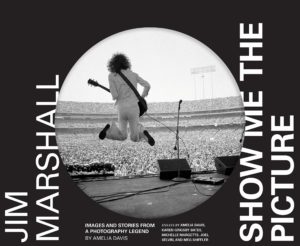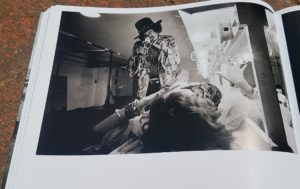
Chronicle Books is set to release a masterful tribute to photographer Jim Marshall (1936-2010) on August 30, 2019.
Entitled Jim Marshall: Show Me the Picture, the collection of Jim’s exquisite, vibey, joyful, and sometimes tear-inducing photos was put together by his long-time personal assistant Amelia Davis. Her professional and personal relationship to Jim was such that he left her his entire estate—pretty much entrusting her to carry on his legacy—and Amelia now owns and runs Jim Marshall Photography LLC.
Such deep access to Jim’s life’s work made it possible for Amelia to include more than 70 images that have never been seen before amongst the 200+ photos included in this volume. While many fans know of Jim from his brilliant photos of ’60s and ’70s rockers, he was far more than a rock photog, and this career-spanning anthology should surprise and delight readers with its expansive portraiture of jazz icons, political and civil rights events, coal miners, denizens of Times Square, and other subjects.

Jim’s photo of Brian Jones, Nico, Dennis Hopper, and Judy Collins at the Monterey Pop Festival, 1967.
Beyond the images, Amelia sought to expose the artist himself with essays by herself, San Francisco journalism icon Joel Selvin, Michelle Margetts (who, as a journalism student at San Francisco State, entered into a relationship with the 28-years-older Marshall), and others.
The text honors the images, informing without imposing on the main event—the photos—and I was captivated by Joel’s historical perspective, as well as the very personal, warts-and-all remembrances penned by Amelia and Michelle. It’s sad that a man who could be talented, impassioned, charming, and truthful enough to entice his subjects to trust him almost absolutely, could also be mean, drug addled, and self-destructive.

The rear cover of the book shows Jim in one of his “moods.”
I had my share of encounters with Jim while I was Editor in Chief of Guitar Player—although our late art director Rich Leeds handled most of the interactions and considered Jim a friend.
One day, Rich walked into my office and, smiling somewhat conspiratorially, said, “Marshall is coming in today. Don’t piss him off. He carries a gun.”
I had never met Jim before, and I didn’t know what to think. Happily, I had a good hang with Jim that day. He was funny and full of fabulous stories. I heard later that when he took off his jacket and tossed it onto the desk of our managing editor, there was a noticeable “clunk.” She checked, and, sure enough. Gun.
As our professional relationship continued, Jim could be really grateful for the magazine’s support, and if he felt I was on his side and respected him, all was well. (He was almost damp-eyed with appreciation when a bunch of the GP staff showed up at one of his gallery shows.) However, if something pissed him off—or if I happened to somehow say the wrong thing at the wrong time—then the “Marshall Monster” would appear, and those encounters, though brief, were not moments you’d ever include on a “good experiences” list. I was eerily reminded of those times while reading through some of Michelle’s and Amelia’s essays—though what I experienced were like ghost shadows compared to what those two brave souls had to endure.

Jim captures Jimi Hendrix filming Janis Joplin backstage at Winterland, San Francisco, 1968.
But the genius of what Jim’s eyes, heart, and Leica lens captured is so remarkable, colossal, and culturally essential that I can’t imagine a world where his images were not there to tell their stories. In fact, the biggest tragedy in my relationship with Jim had nothing to do with his moods or bad behavior. It was about his photos.
For some business reason I don’t remember, Jim was allegedly compelled to “gift” Guitar Player with more than 50 of his classic images. It was a sublime experience indeed to walk through the halls of the GP offices and see so many classic shots hanging on every available wall. I moved through several Guitar Player locations in my 21 years as Editor in Chief, and I never ever got tired of viewing Jim’s work every time I left for lunch, or visited a co-worker’s office, or tested some gear, or, heck, even took a moment to run to the bathroom. It was inspirational to be surrounded by such wonders.
For my all-time favorite office—a third-floor, corner space in the last building the magazine leased before GP transitioned to home offices—I selected a black-and-white shot of Paul McCartney and John Lennon singing on one microphone at Candlestick Park in 1966 for the wall next to my door, and a color shot of The Who for the wall across from my desk. I always felt special sitting in that place—thanks, for the most part, to Jim’s thrilling photography of two of my favorite bands.
Sounds awesome, right?
Well, here’s the tragic bit. When NewBay Media shut down the California offices of Guitar Player, Bass Player, Keyboard, Electronic Musician, and Mix around 2017, I was directed to ship all of Jim’s framed photos to the corporate office in New York City, where Guitar World was still headquartered. That hurt. A lot.
Jim had given those photos to Guitar Player, which for 50+ years was a San Francisco Bay Area institution—as well Jim himself. Releasing those images to the NYC office was one of the hardest business moves I’ve ever had to do. Currently, Future UK is the owner of all of the NewBay Media and Guitar Player assets, and getting Jim Marshall: Show Me the Picture in the mail yesterday caused me to shed a little tear for what I, the GP staff, the GP brand, and even the City of San Francisco itself lost to a corporate takeover. Sorry, Jim.

Jim’s shots of The Who and Jefferson Airplane from Woodstock, 1969.
Personal moaning aside, YOU can view these “lost” GP images and much much more if you order Amelia’s book. The printing is crisp, the paper is tops, and the presentation is worthy of the coolest coffee-table style publications. On every level, leafing through Jim Marshall: Show Me the Picture is a transcendent experience, and not just because of his superb photographic talents.
As with the recently released David Crosby documentary, Remember My Name, Jim Marshall: Show Me the Picture is also an extremely honest look into the mind of a troubled genius. This is a guy who had the sorcery to shoot everything in the camera. No darkroom manipulations or post-production cropping. What Jim saw through his own lens is what we viewed in magazines, newspapers, record covers, books, magazines, and more.
And yet, with all of that magic going for him, sometimes Jim would feel he wasn’t worthy. He’d often disrespect his talent with drugs and drink. He’d exasperate people from time to time, rudely pushing away those who might have helped him when he could have used a hand. He could yell like the Hulk. He could be crude. None of these are lovely traits.
But what he saw through his camera was pure beauty.
To pre-order Jim Marshall: Show Me the Picture CLICK HERE!

A proof-sheet view from the pages of Jim Marshall: Show Me the Picture.




